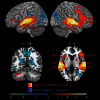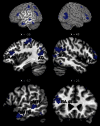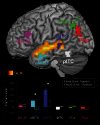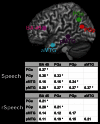Multivariate activation and connectivity patterns discriminate speech intelligibility in Wernicke's, Broca's, and Geschwind's areas
- PMID: 22693339
- PMCID: PMC3673181
- DOI: 10.1093/cercor/bhs165
Multivariate activation and connectivity patterns discriminate speech intelligibility in Wernicke's, Broca's, and Geschwind's areas
Abstract
The brain network underlying speech comprehension is usually described as encompassing fronto-temporal-parietal regions while neuroimaging studies of speech intelligibility have focused on a more spatially restricted network dominated by the superior temporal cortex. Here we use functional magnetic resonance imaging with a novel whole-brain multivariate pattern analysis (MVPA) to more fully characterize neural responses and connectivity to intelligible speech. Consistent with previous univariate findings, intelligible speech elicited greater activity in bilateral superior temporal cortex relative to unintelligible speech. However, MVPA identified a more extensive network that discriminated between intelligible and unintelligible speech, including left-hemisphere middle temporal gyrus, angular gyrus, inferior temporal cortex, and inferior frontal gyrus pars triangularis. These fronto-temporal-parietal areas also showed greater functional connectivity during intelligible, compared with unintelligible, speech. Our results suggest that speech intelligibly is encoded by distinct fine-grained spatial representations and within-task connectivity, rather than differential engagement or disengagement of brain regions, and they provide a more complete view of the brain network serving speech comprehension. Our findings bridge a divide between neural models of speech comprehension and the neuroimaging literature on speech intelligibility, and suggest that speech intelligibility relies on differential multivariate response and connectivity patterns in Wernicke's, Broca's, and Geschwind's areas.
Keywords: Angular gyrus; Auditory cortex; Broca's area; Inferior frontal gyrus; Speech perception.
Figures






References
-
- Bates E, Wilson SM, Saygin AP, Dick F, Sereno MI, Knight RT, Dronkers NF. Voxel-based lesion-symptom mapping. Nat Neurosci. 2003;6:448–450. - PubMed
Publication types
MeSH terms
Grants and funding
LinkOut - more resources
Full Text Sources
Miscellaneous

